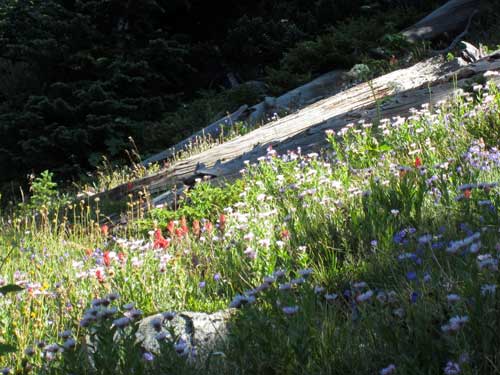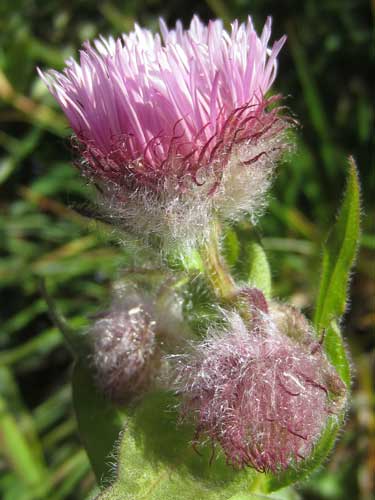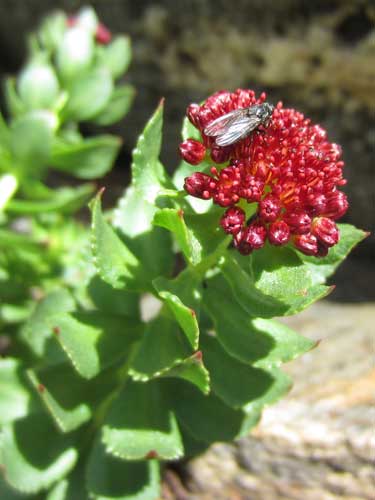Our trek started from the Fourth of July Trailhead. The joke is that it acquired its name because the 5-mile rocky dirt road leading to it is too muddy and impassible before July 4th. The real reason, however, is for the Fourth of July Mine. Allegedly, silver was discovered on that day in 1872. Originally it was claimed to be so big that 100,000 men could mine it for generations. Sadly, that was not the case for numerous reasons. Due to constant flooding from a nearby stream and other issues, the cost of extracting what silver there was (not nearly the amounts dreamed of) quickly outweighed the profits. It closed in 1880.
We set off into the Indian Peaks Wilderness Area. It was surprisingly chilly out.

Rules for being wild

A view of the east side of the southern Indian Peaks, including Mount Neva and Jasper Peak

Crossing a large waterfall that flowed across the trail

Chiming Bells

Yellow Monkeyflower is supposed to resemble a laughing monkey.... just not like any monkey I've ever seen.

The quantity, variety and colors of flowers were incredible!

Blue Columbine

I can actually see how Monkshood gets its name! It is also called Wolfbane since, according to legend, werewolves are driven off by it. I didn't see any werewolves around so it must be working.

Many of these higher elevation flowers wear thick fuzzy 'jackets' to help keep them warm.

A bumblebee sits unmoving, waiting for the morning sun to warm it after a cold night.

Dave watches the stream rush past.
We took a short break alongside a lovely waterfall on the... North Fork of Middle Boulder Creek. Huh?
Boulder Creek is formed by North, Middle and South Boulder Creeks.
North Boulder Creek originates in a valley by Navajo Peak on the Continental Divide. It flows almost 18 miles before joining with Middle Boulder Creek.
Middle Boulder Creek starts as two forks from the Continental Divide: the North Fork coming from Mount Neva and the South Fork from Rollins Pass. They merge and flow another 14 miles (passing through Nederland and Barker Meadow Reservoir) to join North Boulder Creek.
Now one river, these two flow through Boulder and are joined on the east edge of the city by South Boulder Creek, which originated near Moffat Tunnel, having flowed 40 miles (through Eldorado Canyon) to get here.
One big happy family now, Boulder Creek flows northeast, where it joins St. Vrain Creek, the Platte River, the Mississippi River and ultimately the Gulf of Mexico.

North Fork of Middle Boulder Creek... aka snow melt from Mount Neva

Sickletop Lousewort (also Parrot's Beak, Mountain Figwort or Ram's Horns) refers to the flower's distinctive curved shape. It was an old belief was that these plants gave lice to people and cattle.

Dusky Beardtongue is generally a very dark purple but can also sometime be found as this off-yellow.
We left the established trails and headed into the backcountry. Permits to go off-trail are only required for summer camping and large groups.

No more nice fancy bridges!

The Meadow or Canada Anemone is in the Buttercup family.

There are almost 600 species in the Violet family. Some are native to this area, while others have been (far too successfully) introduced from Europe.

This may look like a wasp or bee at first glance, but it is actually a Flower Fly. Being members of the family Syrphidae, there are nearly 900 species in North America. They can’t sting, but their appearance makes birds and other predators think twice.

Heart-leaved Twayblade is a delicate-looking, very tiny orchid that prefers wet areas.

While these next two pictures are what we might typically think of as Buttercups, the family also includes things like Monkshood, Larkspur and even Columbines. Worldwide there are about 2,000 species.

We left the wet meadows and forests and began our steep climb upwards. Slowly the trees thinned out and patches of snow became more prevalent.

Somehow I managed to smack my knee rather badly on this easy-to-jump log. Fortunately, after a few moments of rest, I was able to continue without too much discomfort... although it did carve a small piece out of me.

Dave leads the way!

Paul takes a break after the steep climb. We followed game trails as much as possible.

Almost there...
We crested the ridge and suddenly got a spectacular view of Dave's so-called Secret Valley. It was filled with small ponds, tiny fast-moving streams, marshes and alpine flowers. At the far end were steep cliffs still covered with large patches of snow. One of these snowfields was our eventual destination.

Our spectacular first view

Making our way around the ponds and marshes

Scattered throughout the meadow were pieces of bright orange metal. They were pieces of a small plane that had crashed into one of the peaks back in 1971. The wreckage lay scattered over a full square mile.

On December 14, 1971, a 29-year-old flight instructor, flying from Denver to Steamboat Springs, hit some bad weather and crashed into the sides of one of these peaks. He didn't survive. The main part of the plane still rests higher up. This is a dangerous area, especially during winter when there are strong downdrafts created by wind blowing across the Continental Divide.

Flowers, flowers and still more flowers!

Paintbrush comes in so many different colors... deep red, this vibrant pink and even delicate pastel oranges.

One of my all time favorites, Little Pink Elephants! It is a type of lousewort.

King’s Crown is in the Stonecrop family. It prefers these alpine and subalpine climates.

Showy Jacob’s Ladder (which is related to Sky Pilot or Sticky Jacob’s Ladder) is usually found above 9,000 feet,. It loves to hide in the shadows.

